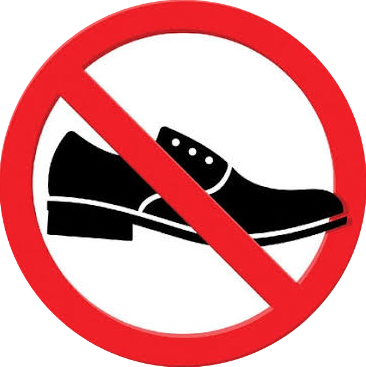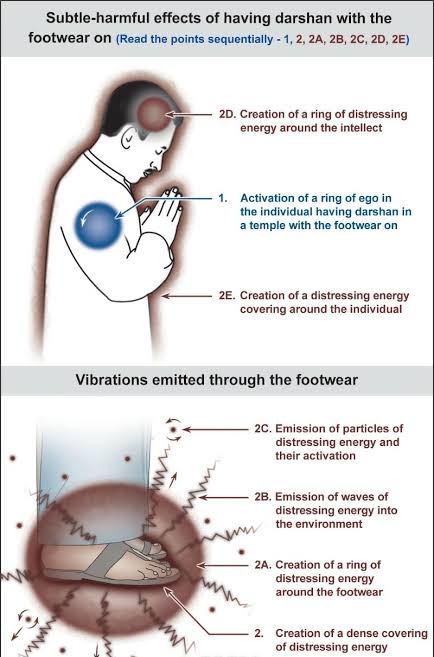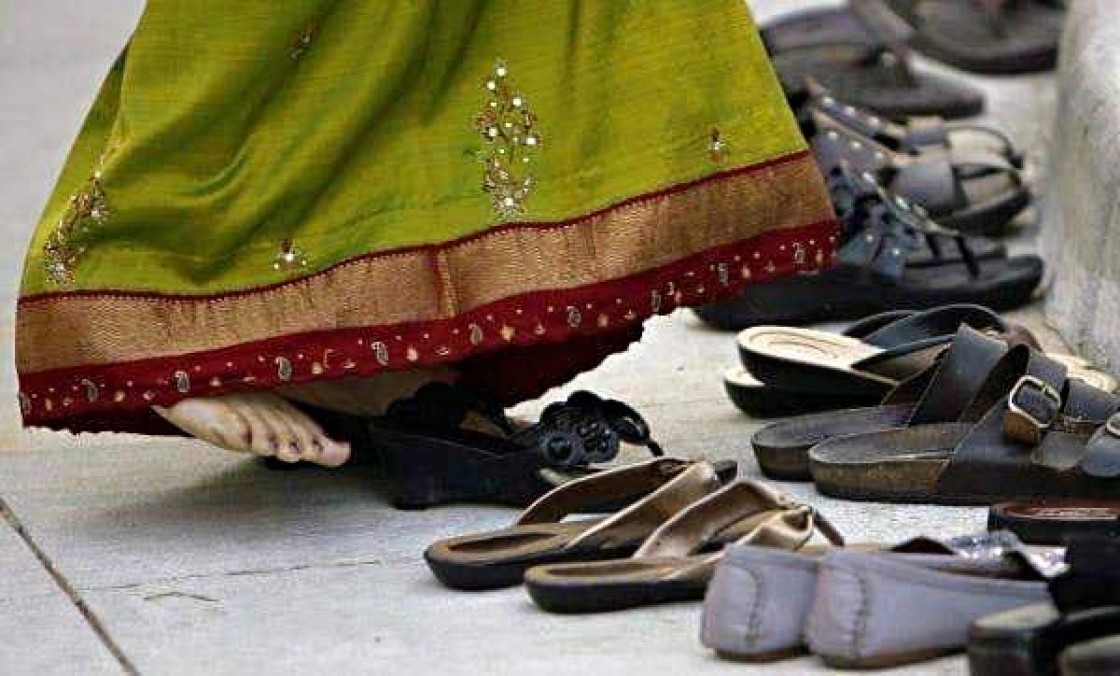Hinduism is a religion with numerous traditions & rituals. There are several practices from the Vedic age that are still popular in Bharat. Entering temples barefoot is yet another customary practice among Hindus. Not only Hindus, other religions also remove their footwear before they enter a holy place. In ancient days, people did not have any footwear. However, a few people, who belonged to the upper class, used to wear footwear made from wood.
Hinduism has many rituals that have a beautiful meaning behind them. Hindus worship in temples & before entering temples we remove our footwear (पादत्राणयुगम्) & wash hands & feet as Foot-wears (पादत्राणयुगम्) are considered impure according to Hindu culture. Not only in temples, people forbid footwear (पादत्राणयुगम्) in their houses also, as we consider it as a mark of respect, honour, cleanliness & purity to the house & we consider the houses as temple too as the house gives us shelter & protection.
Footwear (पादत्राणयुगम्) are generally used to protect our toes & soles of our feet from direct contact with dust, thorns, stones & all sorts of impurities on the roads, because of this it is obvious that footwear (पादत्राणयुगम्) are filled with dirt. So, in order to keep a hygienic atmosphere, we keep the footwear (पादत्राणयुगम्) out of the religious places & houses. As we do not want the impurities to enter such places.

Significance of removing footwear before entering the Temple –
According to the Scriptures, there are 5 such places where one is prohibited to enter wearing footwear (पादत्राणयुगम्) & they are -
1. The room where the Vedic fire has been established. 2. A cow-pen i.e. (Gau Shala) गौ-शाला or where the cows stay. 3. A place where the idol of the Deity is installed, like a temple or a puja room & a room for the Brahmin. 4. A place for taking meals. 5. The room where one chants the Mantras.
There is a spiritual & psychological reason for removing shoes before entering a temple. When visiting a temple, a person may be in a disturbed state of mind. Being barefoot allows the worshiper to be in ‘direct contact’ with the aura of the temple & the idol, as the idol installed in the temple with all the authentic Vedic ritual ceremony of installing breath into the idol (Praanpratistha). Since our feet touch the floor of the temple, this ritual also allows the person to better absorb the positive energy of the temple. Many people also remove any riches & materialistic items from their body, to offer selfless devotion to the Deity.
Removing footwear before entering a temple helps to maintain the sanctity of the temple. We use footwears to keep our feet protected from dirt, pebbles, thorns, etc. & so the sole of the footwear gets impure. The temple is most cleaner & sanctified place, so we keep our dirty footwear outside the temple & then we enter the temple. It is to maintain the hygiene of the temple. Same for the house or any other such holy places. It is a mark of respect, & this is also why people, especially in the Indian culture, apologies when they touch something or someone with their feet. Many people also take off their footwear while meeting elders. It is considered to be good manners, a sign of being a respectable person.
Another reason why footwear is removed before entering a temple, is that often shoes are made of leather, which is made of animal skin. Since Hinduism promotes non-violence & reproaches harm to others, even animals & wearing leather products, wearing footwear made out of leather inside a temple is considered as a violation of the religion & the individual is seen to be disobeying the general rule of the temple & also disobeying the Deity. One should also remove their leather belts & wallets before entering the temple or before starting any holy ritual.
One should leave the luxuries before entering the temple or before worshiping God/Goddesses. So, footwear (पादत्राणयुगम्) is the basic luxury we use & thus we leave it outside as a gesture of respect to the Deities. Usually, Temple authorities display a board which says "Footwears are strictly prohibited" as our temples can be visited by people of other religions who may not be aware of such respect shown by Hindus.

Picture Courtesy- Maharshi Adhyatma Vishwavidyalay.
Scientific benifites of not wearing footwear in the temple -
- Temples are places that offer peace of mind because of the positive energy present in the temple. So, when one enter barefoot, the positive energy enters into the body through the feet which helps in keeping the mind calm.
- Temples have the positive viberations which helps in cleansing energy of our body when our feet is without footwear.
- While entering the temple barefoot, one can improve focus & concentration also, stress & tension can be elimenated which provides relaxation to a disturbed mind.
- A temple has cosmic energy present in its premises as the temple is built on the pious place & the idol is installed with all the Vedic process & every day the chanting of the mantras is done which helps the premises of the temple to regenerate the positive viberations everyday. These energies can bring a change to our bodies. It is because our bodies are the conductors of energy so, can absorb these energies & transfer them through our bodies which enters through the barefoot.
- When one enters the temple barefoot, it provides a cooling effect to the body & balances the body temperature.
- Chakras play a crucial role in balancing the energy flow in the body. When one enters a temple without wearing footwear, it helps to activate the Muladhara or the Root Chakra, as the Root Chakra has a close connection with the Earth. With the barefoot, one can enhance the association with Mother Earth. It will help in removing the blockages from Muladhara Chakra & improves the flow of energy through the body.
According to the Scriptures, when that cosmic energy enters the person, it can cause drastic changes physically,mentally & spiritually. Just as a building is fitted with a lightning rod, which is connected to the ground to “earth” the electricity flowing out of lightning, the human body needs to earth the cosmic currents, which is why, many suggest walking barefoot on the grass or the ground early in the morning to “reconnect” with the earth energy. This not only activate the earth's cosmic energy in the human body, but also to release the negative energy from our body.
Removing footwear outside the temple is a gesture of both, the symbolic & conscious desire to leave behind the worldly desires & the first obvious thing is footwear.
Thus, this is the main reason why the places of worship, one is required to take off their footwears (पादत्राणयुगम्). When the cosmic energy passes through the person, the person is cleansed of any diseases or negative energy & gets generated with the positive cosmic energy. But the same analogy of positive energy also applies in the case of negative energy. Which is why, one should always wear footwear (पादत्राणयुगम्) in a place of possible negative energy, like graveyard, etc.
ज्येष्ठः कृष्णपक्षे १०, २०७६
